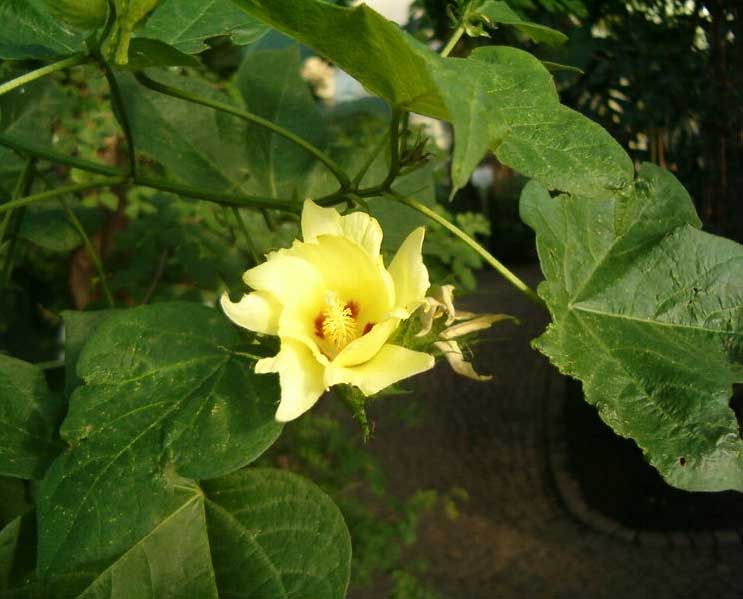
Gossypium hirsutum (*)
Classification System: APG IV
Superregnum: Eukaryota
Regnum: Plantae
Cladus: Angiosperms
Cladus: Eudicots
Cladus: Core eudicots
Cladus: Rosids
Cladus: Eurosids II
Ordo: Malvales
Familia: Malvaceae
Subfamilia: Malvoideae
Tribus: Gossypieae
Genus: Gossypium
Subgenus: G. subg. Karpas
Species: Gossypium hirsutum
Varieties: G. h. var. hirsutum – G. h. var. taitense
Name
Gossypium hirsutum L. (1763)
References
Linnaeus, C. 1763. Sp. Pl., ed. 2, 2: 975.
USDA, ARS, Germplasm Resources Information Network. Gossypium hirsutum in the Germplasm Resources Information Network (GRIN), U.S. Department of Agriculture Agricultural Research Service. Accessed: 07-Oct-06.
Vernacular names
English: Upland cotton
suomi: Teksasinpuuvilla
Gossypium hirsutum, also known as upland cotton or Mexican cotton, is the most widely planted species of cotton in the world. Globally, about 90% of all cotton production is of cultivars derived from this species.[2] In the United States, the world's largest exporter of cotton, it constitutes approximately 95% of all cotton production.[3] It is native to Mexico, the West Indies, northern South America, Central America and possibly tropical Florida.[4][5]
Archeological evidence from the Tehuacan Valley in Mexico shows the cultivation of this species as long ago as 3,500 BC, although there is as yet no evidence as to exactly where it may have been first domesticated.[6] This is the earliest evidence of cotton cultivation in the Americas found thus far.
Gossypium hirsutum includes a number of varieties or cross-bred cultivars with varying fiber lengths and tolerances to a number of growing conditions. The longer length varieties are called "long staple upland" and the shorter length varieties are referred to as "short staple upland". The long staple varieties are the most widely cultivated in commercial production.
Besides being fibre crops, Gossypium hirsutum and Gossypium herbaceum are the main species used to produce cottonseed oil.
The Zuni people use this plant to make ceremonial garments,[7] and the fuzz is made into cords and used ceremonially.[8]
Flowers of Gossypium hirsutum
This species shows extrafloral nectar production.[9]
Synonyms
Gossypium barbadense var. marie-galante (G. Watt) A. Chev., Rev. Int. Bot. Appl Agric. Trop. 18:118. 1938.
Gossypium jamaicense Macfad., Fl. Jamaica 1:73. 1837.
Gossypium lanceolatum Tod., Relaz. cult. coton. 185. 1877.
Gossypium marie-galante G. Watt, Kew Bull. 1927:344. 1927.
Gossypium mexicanum Tod., Ind. sem. panorm. 1867:20, 31. 1868.
Gossypium morrillii O. F. Cook & J. Hubb., J. Washington Acad. Sci. 16:339. 1926.
Gossypium palmeri G. Watt, Wild cult. cotton 204, t. 34. 1907.
Gossypium punctatum Schumach., Beskr. Guin. pl. 309. 1827.
Gossypium purpurascens Poir., Encycl. suppl. 2:369. 1811.
Gossypium religiosum L., Syst. nat. ed. 12, 2:462. 1767.
Gossypium schottii G. Watt, Wild cult. cotton 206. 1907.
Gossypium taitense Parl., Sp. Cotoni 39, t. 6, fig. A. 1866.
Gossypium tridens O. F. Cook & J. Hubb., J. Washington Acad. Sci. 16:547. 1926.
References
Wegier, A.; Alavez, V.; Vega, M.; Azurdia, C. (2019). "Gossypium hirsutum". IUCN Red List of Threatened Species. 2019: e.T71774532A71774543. doi:10.2305/IUCN.UK.2019-2.RLTS.T71774532A71774543.en. Retrieved 15 November 2022.
World Cotton Production, Yara North America
"USDA ERS - Cotton Sector at a Glance". www.ers.usda.gov. Retrieved 2019-02-18.
"Gossypium hirsutum". Germplasm Resources Information Network (GRIN). Agricultural Research Service (ARS), United States Department of Agriculture (USDA). Retrieved 18 December 2017.
Wendel; et al. (November 1992). "Genetic Diversity in Gossypium hirsutum and the Origin of Upland". American Journal of Botany. JSTOR. 79 (11): 1291–1310. doi:10.2307/2445058. JSTOR 2445058.
Smith, C. E.; Stephens, S. G. (1971). "Critical identification of Mexican archaeological cotton remains". Economic Botany. 25 (2): 160. doi:10.1007/BF02860076. S2CID 24273337.
Stevenson, Matilda Coxe 1915 Ethnobotany of the Zuni Indians. SI-BAE Annual Report #30 (p. 77)
Stevenson, p.92
Röse USR, Lewis J, Tumlinson JH. Extrafloral nectar from cotton (Gossypium hirsutum) as a food source for parasitic wasps. Functional Ecology 2006; 20:67-74.
Retrieved from "http://en.wikipedia.org/"
All text is available under the terms of the GNU Free Documentation License

